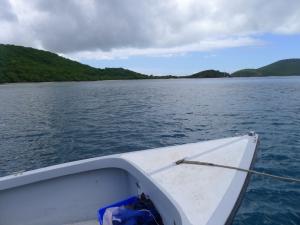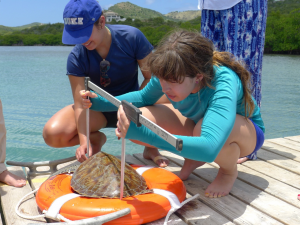Sure, that’s the usual phrase, but when you wake up before the sun rises it’s not necessarily a saying you might use. Instead, at 5:30am we are woken up by a light knock on our door and a cheery voice that asks, “everyone up?!” As our groggy replies signal, we are awake and somewhat coherent.
Rolling out of bed, the 10 of us shuffle across our rooms to get ready for day three of our beach hikes on Resaca and Brava. We go early not only so we will be able to meet Carlos and the rest of the turtle crew on time at 9am for more tagging, but also to beat the heat and identify new nesting sites as soon as possible.
As 5:55 am rolls around, our departure time is fast approaching and our shuffling turns to haste as we all race downstairs to catch our rides. Waters and cliff bars in hand, Kelly takes a group to Brava and Matthew takes a group to Resaca.
The sky is finally starting to brighten as we arrive to our destinations, and stopwatches are started as the groups hit their trails. Though it is only the third day, these hikes are already routine. The Resaca group gets to the beach faster than any day before (not that it was a race…) and shoes are kicked off at the first sight of sand. We head down the long side of the beach first and reach the rocky outcropping that defines the beach’s end without seeing any new nests. The Brava group on the other side of the outcropping has a similar fate. We turn back around to check the other end – again, nothing new. Regardless, there is arguably no better way to start the morning than surveying these beautiful beaches as the sun rises and as the turquoise Caribbean waves break on the shore.
With our last beach hike in the books, we head back up the trail and make our way back to the dorm to eat, pack lunch, and gather our snorkel gear for our second day of net-assisted capture surveys. We meet Carlos at the dock, load up our gear, and we’re off to Manglar!
After a good practice run with the net captures yesterday, we’re ready for what is in store for us today. Manglar is much more productive than Culebrita, attracting more turtles that we will hopefully catch. When we arrive, the difference in production is apparent just by the darker color of the water itself. Here, visibility is not as great as in Culebrita, and when we jump in, grass and sea cucumbers decorate the floor. As we swim towards the net we see rays, conch, and significantly large barracuda; if we weren’t awake before we are now… those barracuda are sneaky!
When we finally reach the net we repeat the same process as yesterday – swim parallel until we spot a turtle! Throughout the first hour four turtles are captured and transferred to the boat. It’s a slow start, but we plan on setting the net again this afternoon so it’s sufficient for now.
About half of the group catches a boat ride back to the dock, while the other half snorkels over, trying to stay in the water as long as possible on this hot, hot day. Once we get to the dock, it’s time for processing! Again, the group splits up to be as efficient as possible. Five to six people are on the boat checking for PIT tags, and inserting them if there aren’t any. Same goes for the flipper tags as well. Once the turtle’s tag numbers are recorded, they are moved to the dock where the rest of our team weighs, measures, and photographs the turtle. Scars, injuries, and individual variation are also recorded for future identification.
Finally, one-by-one each turtle is set free, and a student waits in the water with a GoPro to record a release video. Those turtles are like rockets once they hit the water!
Now that one net is done it’s nearly noon and we take an hour break for lunch before setting the second net. The aroma of peanut butter fills the humid air.
We rest, fill up on water, and reapply sunscreen before going out again. When Carlos give us our queue, we hop back in the boat to go set the second net around the same site as our first. After more than an hour, all that gets entangled in the net is a spotted eagle ray (which we of course let go!)
Though we were told this site is booming with turtles, when we only caught four throughout the entire day Carlos explains to us that sometimes it depends on the time of day that the turtles are active. It is also important to have zero’s sometimes for science!
But not wanting to end the day with no turtles, Carlos decides that we will visit one more site just in case. As we boat towards Mosquito, he explains that this site is actually very slow for turtle captures, and they usually leave here with none as well. However, it is still very important to keep going back every once in a while just to check, otherwise no one would ever know if turtle activity in the area was increasing. Either way, today was not out of the ordinary and no turtles were caught at Mosquito. After 30 minutes the net is pulled in and our field work for the day comes to a close.
We get home, shower, go to eat in town and relax a little before our evening lecture. Carlos gave us great insight about the feeding grounds of marine turtles as well as techniques and methods used for optimal population monitoring at index sites. His lecture also stressed the importance of discovering trends and relaying those to the public through educational and outreach workshops. The volunteer opportunities he offers for students like us are just one example of great ways to get the public involved and increase excitement about conservation and monitoring projects like his. We are grateful that him and his team are allowing us to participate so closely with them, and we’re excited (and sad) for our last day of turtle captures for tomorrow!
¡Buenas noches!
Katy Bonaro




